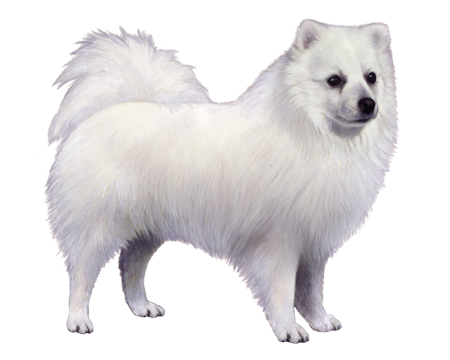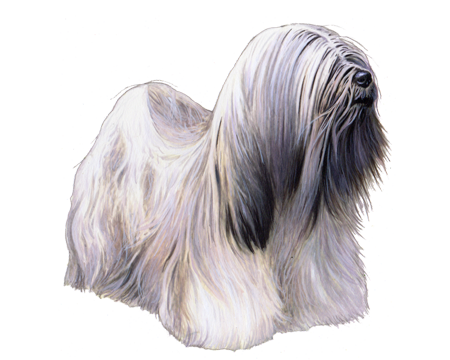
Karelian Bear Dog
If you're searching for an energetic, affectionate dog breed, look no further than the Karelian Bear Dog. These pups generally favor country life—where they can run free and get lots of exercise—over city living.
Interested in discovering if your dog is a Karelian Bear Dog?
Check out Wisdom Panel's DNA tests.

Karelian Bear Dog Traits
General Appearance
Karelian Bear Dogs have charming eyes, typically surrounded by black coloring. Many KBDs have a white blaze and large nose, giving them an endearing appearance.
Coat and Coloring
The breed standard currently calls for black-and-white marked dogs. Karelian Bear Dogs have white coloring in a band around their necks and across the throat, chest, and paws. Combined with a striking jet-black coloring, the dog has a stunning, unforgettable look.
Distinctive Physical Traits
The Karelian Bear Dog is solidly built, with a broad, deep chest.
Karelian Bear Dog Temperament
Intelligent, alert, and powerful are fitting words to describe the Karelian Bear Dog. Devoted and loyal, their protective nature makes KBDs good guard dogs.
They are likely to be reserved with strangers and can be very territorial. But they aren't aggressive with humans.
Karelian Bear Dogs are confident, enthusiastic hunters with an excellent sense of direction. Their sense of smell is particularly sharp—perfect for hunting big game.


Karelian Bear Dog History
The ancestry of the Karelian Bear Dog (known as the "KBD" for short) dates back to Stone Age-era Europe and Scandinavia. Developed by Russian and Finnish peasants to hunt and guard, Karelian Bear Dogs are among the world's oldest breeds.
Karelian Bear Dogs earned their current name around 1936. Hunters needed a dog to bark at large game, including moose, lynxes, wolves, and—as you might expect—bears. The Finnish Kennel Club registered the first Karelian Bear Dogs in 1946, just a year after the first breed standard for the KBD was established.
Today, the Karelian Bear Dog is one of the top 10 most common breeds in Finland.
Karelian Bear Dog Care
Nutrition
As all dogs do, the Karelian Bear Dog needs to eat high-quality food that's appropriate for their life stage (e.g., puppy, adult, senior). To keep your KBD at a healthy weight, monitor food portions and cut back if they start to gain weight. And be sure to take treats into account when tracking their daily calorie intake. As a guideline, treats should make up no more than 10% of your dog's calories.
Grooming
In addition to regular brushing, Karelian Bear Dogs need only occasional baths. All dogs need their nails trimmed periodically. And a regular grooming routine for a Karelian Bear Dog should also include ear checks for wax buildup or debris to prevent infections.
Dogs need dental care, too. In addition to professional dental care, establish a regular at-home dental care routine. It should include daily toothbrushing and dental chews or treats for your Karelian Bear Dog. Maintaining good dental hygiene is essential for their overall long-term health.
Exercise
Karelian Bear Dogs love exercise—whether it's play in a fenced area or leisurely walks. Other outdoor activities like swimming, hiking, and retrieving balls or frisbees can provide a good outlet for any pent-up energy a Karelian Bear Dog may have. The breed also enjoys dog sports such as agility, obedience, and rally.
Training
Karelian Bear Dogs have an independent personality and can be stubborn.
These personality traits can make them difficult to train, especially if you are a novice or first-time owner. It's essential to establish firm leadership using confident and consistent but gentle methods.
Reward-based training with treats, praise, and a gentle stroke on the back after a task well done will help keep your Karelian Bear Dog enthusiastic and stimulated. Early socialization is also key to the healthy development of any dog.
Karelian Bear Dog Genetic Health Conditions
-
Chondrodysplasia (Discovered in Norwegian Elkhound and Karelian Bear Dog)
Chondrodysplasia is a skeletal disorder that leads to the development of shorter than normal legs.
-
Hypophosphatasia
This early onset condition originally discovered in Karelian Bear Dogs is a metabolic bone disease that disturbs skeletal mineralization.
-
Pituitary Dwarfism (Discovered in the Karelian Bear Dog)
Pituitary Dwarfism is a hormone disorder characterized by stunted growth and coat abnormalities, such as a retained puppy coat or excessive coat thinning. The associated genetic variant has been identified in the Karelian Bear Dog.
Knowing if your Karelian Bear Dog is a carrier or at-risk for these conditions can help you and your veterinarian plan for your pup’s lifelong care. With Wisdom Panel™ Premium, you can get results for over 200 genetic health tests.
Breed Group
Companion
This group consists of dogs typically bred for the specific purpose of human companionship, and many are popular pets because of their gentle nature. They became more common as the concept and luxury of dogs as pets prevailed.
Resources
https://www.akc.org/dog-breeds/karelian-bear-dog/
Reviewed July 26, 2020 by Annette Louviere, DVM



























_Color.png)










